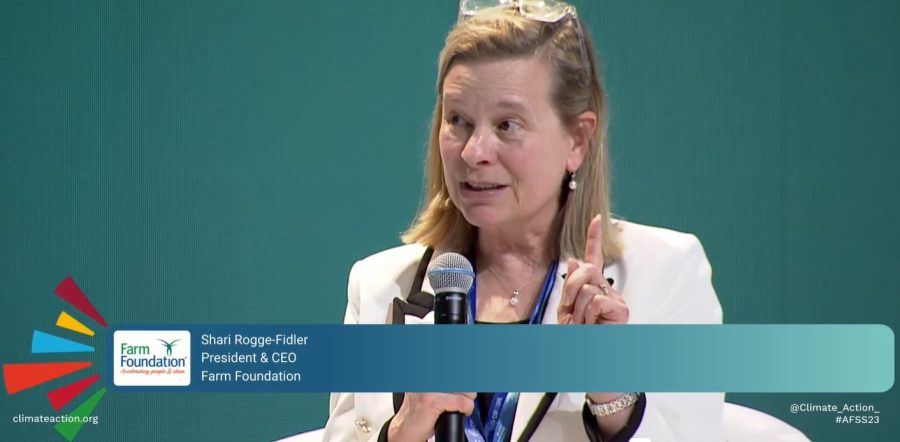Blog
Four Gaps in Connecting the Value Chain from Farm to Fork
Farm Foundation President and CEO Shari Rogge-Fidler spoke at the Agri-Food Systems Summit at COP28 in Dubai, UAE. The event was hosted by Climate Action, in collaboration with the Food and Agriculture Organization of the United Nations (FAO) in the Innovation Zone with the theme of mobilizing the innovation ecosystem. Shari’s panel topic was “Connecting the Value Chain: Farm to Fork.” During her remarks, she identified four gaps which need to be addressed to unlock innovations at the farm level and fully connect the value chain from farm to fork. A recording of the full session, on which the below transcript is based, is available on the Agri-Food Systems Summit webpage. The following begins at the 24-minute mark of the recording and has been slightly edited for clarity.
First, thanks to Climate Action for including me here as a farmer. I think that’s an important voice and I’m actually wearing three hats here at COP. The only reason I’m here at COP is because I’m first and foremost a farmer and I’m part of a farmer delegation. I was brought here by Solutions from the Land which I think is a really powerful name because farmers are providing solutions from the land. And then the third hat I’m wearing is with Farm Foundation, a 90-year-old think tank/do tank. I’m a practical farmer and Farm Foundation is trying to drive practical solutions.

First of all, when we say, “connecting the value chain from farm to fork,” even though we usually say, “farm to fork,” it’s often the farms that are last in the conversation and last to the table and last in the solutions. I think we really need to invert that because as a 5th-generation farmer I’m so passionate about the role of farmers in driving solutions. We’re seeing a tsunami of innovations coming from farms all around the world and including on my own farm, and it’s not because we’ve been told to do this. It’s not because we’ve been told to save the planet. It’s not because we’re trying to hit sustainability goals for companies. It’s because we need to do that on our own operations to sustain it for the next generation. With all these innovations going on, it’s a very exciting time to be involved in agriculture.
I come with hope, despite in my first 24 hours of being here feeling frustrated already about COP as they eliminated the word “farmer” from the documents, for example, from the discussions. But the kind soul in the front row over here encouraged me, saying, “You know we don’t have to wait for COP. We are already doing these innovations in the private sector and can keep moving forward.” However, I would say there are four gaps that all of us collectively need to try to solve to drive innovations forward. Some of them are simple, some of them are more complex. The gaps that I see are language gaps, data gaps, resource gaps, and contract gaps for connecting the farm to fork.
Contract gaps: I’ll start with that one. It’s the easiest. So many farms are fragmented and not part of the contracts going on with the big food companies. Sometimes they want to be involved in those contracts, but they don’t know how to connect to the exciting things going on with the other end of the supply chain.
Language gaps: In our own little echo chambers, I think we all think we understand what regenerative ag is, for example. We talk about it, maybe every day. But in my farm community, if you polled our county, I don’t think anyone would know what the word “regenerative agriculture” means. That’s not the language that we use. That one seems like an easy one that we should be able to solve. I think soil health is the connector for us all so let’s connect solutions to soil health when we talk about regenerative agriculture.
Data gaps is one of the more complex ones to solve for. One of our panelists talked about metrics, but it’s not even just the metrics that matter. It’s the data and the data flow that is so disaggregated, fragmented, and we need data interoperability as well. That’s actually part of what Farm Foundation is trying to help solve, some of those pain points.
The fourth one is resource gaps. On my farm I would consider us early adopters. We’ve been doing no till and cover crops for several years. But I’d say we’ve reached a plateau in our ability to drive that forward. We’re having some problems with the stand of our cover crops. And we lack the resources to help us get to the next level in our solutions. I think that’s just one example of the resource gap that we need to try to fill if we want to continue to drive these solutions forward.
Despite those gaps, I come back to the fact that I am optimistic and hopeful. I think we all have to continue to collaborate to close those gaps to continue to drive innovation and solutions forward.
